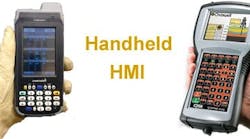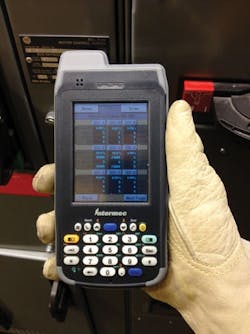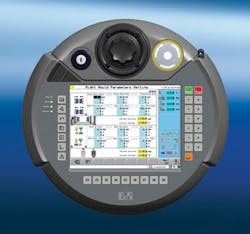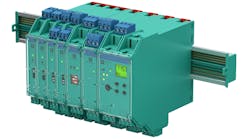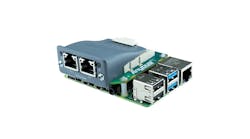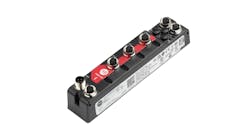We integrate multiple machines into a complete manufacturing process line. The operator has to physically attend to all of the machines. Rather than have an HMI at each machine, we're thinking about handheld HMI, maybe wireless, that the operators would carry with them. We'd like to hear about experiences with this approach.
—From February '12 Control Design
SEE ALSO: Reader Feedback: Handheld HMI Pitfalls
Answers
Single-Operator Capabilities
The ease and cost of deploying your handheld HMI solution will depend on a couple of criteria: the level of functionality you desire from the handheld, and your current infrastructure.
A remote access capability that allows operators and plant managers to view the system from anywhere can be quite simple. Being able to see the entire operation in real time can be extremely helpful when a plant manager or maintenance personnel get a call from an operator in the middle of the night, allowing them to log in remotely to either dismiss the alarm or help the onsite team troubleshoot over the phone. If you are looking for the full functionality of your current stationary HMI in a mobile platform, a system integrator or your distributor can help you determine the best design and components to use.
We work on older, hydraulically powered, multi-axis systems, so we have a big interest in them not all converting entirely to electrically powered alternatives. By sharing a pump across many axes of motion, we believe we can keep our per-axis cost in line with any solution. We'd like to hear what tips readers have for ensuring a well-tuned hydraulic system with emphasis on the controls and the embedded sensors.
Send us your comments, suggestions or solutions for this problem.
We recently installed a mobile HMI that offered full manual control of all machines and devices at a flour mill. The mobile HMIs also have barcode scanners, so operators can scan a machine or component and the HMI automatically will bring up the manual control screen for that device.Prior to getting the handhelds, in the case of an alarm, a plant operator would have to travel as many as six stories to the control room to acknowledge the alarm and identify the issue before heading out to the device to enact necessary changes, only to then return to the control room to reset the alarm. Mobile HMIs allow operators to see an alarm from any area of the plant and immediately log in to the manual control screen to reset the alarm (if all is well), or make the necessary changes to fix the problem and restart — all from their mobile location. This also allows the facility to run with only a single operator on staff at any given time.
We selected Intermec model CN4-C PDAs as the mobile HMI hardware for this facility primarily because of the intrinsic safety rating. The plant had an existing control system that used FactoryTalk View Site Edition HMI software from Rockwell Automation for visualization. We created an app for FactoryTalk View SE that allows the PDAs access to the system via remote desktop session. The screens from the stationary control system HMI were optimized for the mobile platform.
A centralized security service adds the ability to configure user and group permissions within the system so only verified users are able to log in via the stationary system or the mobile HMIs. If you require additional levels of security, certain vendors offer secure overlays for handheld devices.
If you are working from your existing control system and have a visualization application already running that you can tap into remotely, you will save the cost of purchasing that server, as well as a new software licensing fee. A wireless infrastructure would be required, and you would want to confirm you do not have problematic weak signal points in your facility. Additionally, you will need to determine what devices would work best in your plant environment. Many of our customers are excited about the capabilities of the latest consumer devices, only to determine they need a device that can hold up in an industrial setting. This could involve anything from the temperature rating of the hardware to requiring the ability to clip on to the body for use on a manlift or other plant equipment, for example.
A mobile HMI solution can save a lot of time and money, but the investment in creating the solution could vary greatly depending on what functionality you desire from the mobile platform, your current wireless infrastructure, and what control system you already have in place.
Reid Vander Veen,
business development,
Interstates Control Systems
Manufacturing Awareness
Mobile HMIs have been used for years to monitor machines and industrial processes. The advent of new technologies and the recent popularization of mobile devices such as tablets, PDAs and cellphones on a larger scale have accelerated the adoption of mobile HMIs in many industries.
Using built-in tools from HMI packages, operators could receive remote notification for alarm conditions immediately and have the information they need to diagnose the problem immediately.
This advantage is pointed out by Dan McCarthy, ASME central engineering manager for Chrysler: "Mobile HMIs create the tool for manufacturing awareness," he says. "Today's production requirements drive management and engineering to be fully aware of the activity on the manufacturing floor at all times. The ability to have such valuable information at their fingertips in real time enables professionals to manage their activities and responsibilities efficiently anywhere, anytime."
It is also true that some points should be taken into consideration when adopting a mobile HMI solution:
Availability: To take full advantage of the solution, the operator's handheld device should communicate with the controllers (e.g. PLCs) through a wireless network such as Wi-Fi. Industrial wireless hubs and switches available in the market provide a high level of availability and decent ranges. However, it is important to plan where the access point(s) will be located to make sure that the user will have enough signal strength within the area of interest. Moreover, mobile devices require batteries, and the users must follow a schedule to recharge the devices so they have enough energy to operate when required.
Security: It is easier to restrict access to a wired network than to a wireless network. When using mobile HMIs in a manufacturing process, it is imperative to follow guidelines to prevent unauthorized access to the system, such as configuring a strong, encrypted key for the access point(s), making sure that only authorized personnel have access to such keys, changing the password regularly, and other security measures.
Furthermore, since most controllers currently deployed in automation systems support protocols that do not require authentication, connecting the controllers directly to the wireless network increases the risk of attacks. In this case, it is recommended to use an HMI (or SCADA) node as the gateway between the handheld devices (wireless network) and the PLCs (wired network). This way, even if someone accesses the wireless network, there is another layer of protection — the HMI/SCADA software — shielding the control network (PLCs) from the remote user.
In our experience, the most successful use of mobile HMIs on the plant floor is when they are used as an additional tool to augment the traditional fixed HMIs. In other words, instead of replacing the fixed panels with handheld devices, both interfaces are deployed concurrently in the plant. Fixed HMI panels provide high availability to critical operational tasks, while mobile HMIs provide remote notification and diagnostics to reduce the time to identify and resolve problems, reducing the cost associated with downtime and increasing the productivity.
Mobile HMIs are particularly useful for tasks that are not suitable for fixed panels, such as calibration of large machines. Instead of having one operator calibrating the machine and another one in front of the HMI checking the result of the calibration, a single operator with a handheld device can monitor in real time the result of the calibration wherever this operation has to be executed.
Mobile HMIs are commonly used not only as an operational tool, but also as an analysis tool by plant supervisors and managers to monitor online data and history data in dashboards that provide key performance indicators (KPIs), such as overall equipment effectiveness (OEE) at their fingertips.
Fabio Terezinho,
vice president of consulting services,
InduSoft, www.indusoft.com
Flexible Solution
Handheld HMIs have been a common requirement for certain applications, such as overhead cranes, for a number of years in both wired and wireless formats. This is becoming more common in other application areas typically served by machine-based HMI devices for a variety of reasons, including technological advances that have made wireless devices and networks ubiquitous, and user demand for greater operating efficiency and freedom.
Handheld HMI devices can come in a variety of shapes and forms, from industrialized handheld units to consumer products such as an iPad or iPhone. The industrialized units typically incorporate some type of display (perhaps touch), more traditional operator devices (e.g. pushbuttons, switches, dials), and a hardwired cable connection to the machine. The hardwired connection can be permanent in some cases, limiting the benefits of the device to a single machine. As an alternative, some hardwired solutions could incorporate cables equipped with quick-disconnect connectors, allowing operators to easily move it from machine to machine. This extends the benefits of operating a machine from a mobile device across multiple machines.
Wireless solutions can offer a greater degree of freedom when using handheld HMIs across several machines, and the range of available devices is greater because both industrial and consumer devices could be used. As before, however, several application considerations must be accounted for in the machine design, ranging from how to keep the devices from disappearing, to determining how to ensure that the operator knows which machine he is controlling. A wireless solution comes with some degree of latency that could also impact machine operation. Machine builders have to ask whether this limits what can be done from the handheld HMI.
Safety and security also are factors to consider when determining if a wireless handheld HMI is the correct solution. The overall security of the wireless interface should prevent unauthorized access to machine operation. Open-standard, digital safety networks now exist that enable the handling of safety-certified functions over a wireless connection, across multiple machines. As with other operating functions, you should consider the latency associated with the wireless connection.
When correctly implemented, handheld HMIs can be extremely flexible and robust solutions for machine builders in a number of different applications.
Corey Morton,
solutions architect,
Daniel Ghizoni,
senior solutions engineer,
B&R Industrial Automation, www.br-automation.com
For Peat's Sake
Portability and mobility are essential in the present scenario. Since most PDAs readily support wireless RF (Wi-Fi and Bluetooth) capability, untethered communication links to the controllers is possible wherever the controller communication interface can be converted to a wireless medium.
All you need then is HMI software running in a handheld PDA with capability to access the PLCs, where the I/O from the various machines are brought in for monitoring and control under the programmed logic in the PLC.
The PLC should be wireless-enabled, which is easy to accomplish using a wireless adapter (access point) if the PLC has an Ethernet port. If only a serial port is available, then use of a serial/Ethernet adapter takes care of the conversion.
Wireless HMI can enable an operator to move from machine to machine as he monitors and controls systems in a variety of fields. In one example, we helped a packager of peat moss products simplify operation on its form, fill and seal baggers; automatic palletizer; robotic palletizer; and stretch wrapper machines. The customer previously had to walk to the top of the machine to start or stop it, or to determine any problem. Now the customer can see the issue with the machine directly on the wireless PDA, and can start and stop the machine remotely, minimizing valuable down time.
HMI software in conjunction with a wireless link to relevant information lends a helping hand to the human decision maker to zero in on the critical subsystem that needs his attention and take appropriate timely action. You should be able to accomplish the multi-machine mobile monitoring and control task using a PDA-based HMI in a simple, natural and straightforward manner.
Ramal Murali,
president,
Software Horizons, www.instanthmi.com
Wireless Fears
Most HMIs connect with some device such as a barcode scanner, PLC or controller by using some type of communication port like a serial or Ethernet port. So some people have concerns about the safety of handheld wireless, and might choose to not use it.
There are three key elements when doing HMI: alarm, control and monitor. If the HMI is used for information monitoring and/or alarm to collect data, then a handheld HMI solution would be a good fit. If, however, the HMI is doing control, it might not be the best way to use a wireless solution.
Jonney Chang,
HMI product manager,
Advantech, www.advantech.com
Sponsored Recommendations

Leaders relevant to this article:
